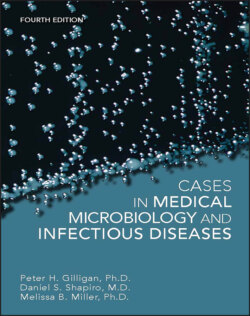Читать книгу Cases in Medical Microbiology and Infectious Diseases - Melissa B. Miller - Страница 16
SPECIMEN SELECTION, COLLECTION, AND TRANSPORT
ОглавлениеEach laboratory test has three stages.
1 1. The preanalytical stage: The caregiver selects the test to be done, determines the type of specimen to be collected for analysis, ensures that it is properly labeled with the patient’s name, and facilitates rapid and proper transport of this specimen to the laboratory.
2 2. The analytical stage: The specimen is analyzed by the laboratory for the presence of specific microbial pathogens. The remaining sections of this chapter describe various analytic approaches to the detection of pathogens.
3 3. The postanalytical stage: The caregiver uses the laboratory results to determine what therapies, if any, to use in the care of the patient.
The preanalytical stage is the most important stage in laboratory testing! If the wrong test is ordered, if the wrong specimen is collected, if the specimen is labeled with the wrong patient’s name, or if the correct specimen is collected but is improperly transported, the microbe causing the patient’s illness may not be detected in the analytical stage. As a result, at the postanalytical stage, the caregiver may not have the appropriate information to make the correct therapeutic decision. The maxim frequently used in laboratory medicine is “garbage in, garbage out.”
Specimen selection is important. A patient with a fever, chills, and malaise may have an infection in any one of several organ systems. If a patient has a urinary tract infection and if urine is not selected for culture, the etiology and source of the infection will be missed. Careful history taking and physical examination play an important role in selecting the correct specimen.
Continuing with the example of a patient with a fever due to a urinary tract infection, the next phase in the diagnosis of infection is the collection of a urine specimen. Because the urethra has resident microbiota, urine specimens typically are not sterile. A properly collected urine specimen is one in which the external genitalia are cleansed and midstream urine is collected. Collection of midstream urine is important because the initial portion of the stream washes out much of the urethral microbiota. Even with careful attention to detail, clean-catch urine can be contaminated with urethral microbiota, rendering the specimen uninterpretable at the postanalytical stage.
An important concept when considering the transport of clinical specimens for culture is to recognize that they contain living organisms whose viability is influenced by transport conditions. These organisms may be killed by changes in temperature, drying of the specimen, exposure to oxygen, lack of vital nutrients, or changes in specimen pH. Transport conditions that support the viability of any clinically significant organisms present in the specimen should be established. It should also be noted that the longer the transport takes, the less likely it is that viability will be maintained. Rapid transport of specimens is important for maximal accuracy at the analytical stage.
If the correct test is selected, the proper specimen is collected and transported, but the specimen is labeled with the wrong name, the test findings might be harmful to two different patients. The patient from whom the specimen came might not receive the proper therapy, while a second patient whose name was mistakenly used to label the specimen might receive a potentially harmful therapy.
